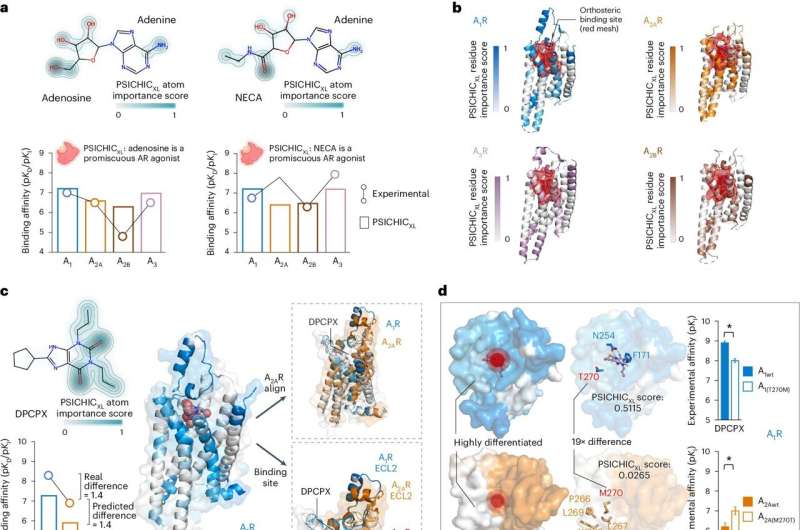This article has been reviewed according to Science X's editorial process and policies. Editors have highlighted the following attributes while ensuring the content's credibility:
fact-checked
peer-reviewed publication
trusted source
proofread
New AI tool for rapid and cost-effective drug discovery

Australian researchers, led by Monash University, have invented a new artificial intelligence (AI) tool which is poised to reshape virtual screening in early stage drug discovery and enhance scientists' ability to identify potential new medicines.
Although computational methods within drug discovery are well established, there is an indisputable gap when it comes to novel AI tools capable of rapidly, robustly and cost-effectively predicting the strength of interactions between molecules and proteins—a critical step in the drug discovery process.
The Australian invention "PSICHIC" (PhySIcoCHemICal) brings together expertise at the interface of computing technology and drug discovery to offer an entirely new approach.
Published in Nature Machine Intelligence, the study demonstrates how PSICHIC uses only sequence data, alongside AI, to decode protein-molecule interactions with state-of-the-art accuracy, while eliminating the need for costly and less accurate processes such as 3D structures.
Dr. Lauren May, co-lead author from the Monash Institute of Pharmaceutical Sciences (MIPS), said the team has already demonstrated that PSICHIC can effectively screen new drug candidates and perform selectivity profiling.
"Comparison of experimental and AI predictions of a large compound library against the A1 receptor—a potential therapeutic target for many diseases—demonstrated PSICHIC could effectively screen and identify a novel drug candidate. Moreover, PSICHIC was able to distinguish the functional effects of the compound or, in other words, the way in which the drug might affect our bodies," Dr. May said.
"There is enormous potential for AI to completely change the drug discovery landscape. We foresee PSICHIC reshaping virtual screening and deepening our understanding of protein-molecule interactions."
Data scientist, AI expert and lead author, Professor Geoff Webb from Monash's Department of Data Science and Artificial Intelligence, said while other methods for predicting protein-molecule interactions already exist, they can be expensive and falter in their ability to predict a drug's functional effects.
"The application of AI approaches to enhance the affordability and accuracy of drug discovery is a rapidly expanding area. With PSICHIC, our team has eliminated the need for 3D structures to map protein-molecule interactions, which is a costly and often restrictive requirement," Professor Webb said.
"Instead, PSICHIC identifies the unique 'fingerprints' of specific protein-molecule interactions by applying AI to analyze thousands of protein-molecule interactions, resulting in faster and more effective screening of drug compounds without the need for rendering protein or molecule structures in high-resolution 3D."
Dr. Anh Nguyen, co-lead author from MIPS with strong expertise in AI approaches to drug-receptor interactions, emphasized the importance of these interactions.
"Interactions between molecules and proteins underpin many biological processes, with drugs exerting their intended effects by selectively interacting with specific proteins. There have been significant global efforts to develop new AI-based methods to accurately determine how a molecule might behave when it interacts with its protein target—after all, this is the core building block to making medicines," Dr. Nguyen said.
First author Huan Yee Koh, a Ph.D. candidate from Monash's Faculty of Information Technology, highlighted the motivation behind the design of PSICHIC for drug discovery.
"AI has the potential to dramatically improve the robustness, efficiency and cost at multiple stages during the drug discovery process, from early stage discoveries right through to predicting clinical responses. However, since many AI systems fundamentally rely on pattern matching, these systems can suffer from unrestrained degrees of freedom. This can lead to memorization of previously known patterns rather than learning the underlying mechanisms of protein-ligand interactions, ultimately hindering the discovery of novel drugs," Mr. Koh said.
"PSICHIC addresses this issue by incorporating physicochemical constraints into its AI model when learning from sequence data. This enables PSICHIC to attain capabilities in decoding the mechanisms underlying protein-ligand interactions directly from sequence data, bypassing the need for costly structures and making drug discovery more efficient and reliable."
Professor Shirui Pan, co-lead author and an ARC Future Fellow with the School of Information and Communication Technology at Griffith University, said the fact PSICHIC requires only sequence data for operation means it is uniquely accessible.
He added, "Compared to previous deep sequence-based methods, this approach provides a more faithful representation of the underlying protein-molecule interactions, thereby closing the performance gap between sequence-based methods and structure-based or complex-based methods."
More information: Huan Yee Koh et al, Physicochemical graph neural network for learning protein–ligand interaction fingerprints from sequence data, Nature Machine Intelligence (2024). DOI: 10.1038/s42256-024-00847-1
The PSICHIC team has made their data, code, and optimized model available to the broader scientific community. Visit www.psichicserver.com for more information.
Journal information: Nature Machine Intelligence
Provided by Monash University





















